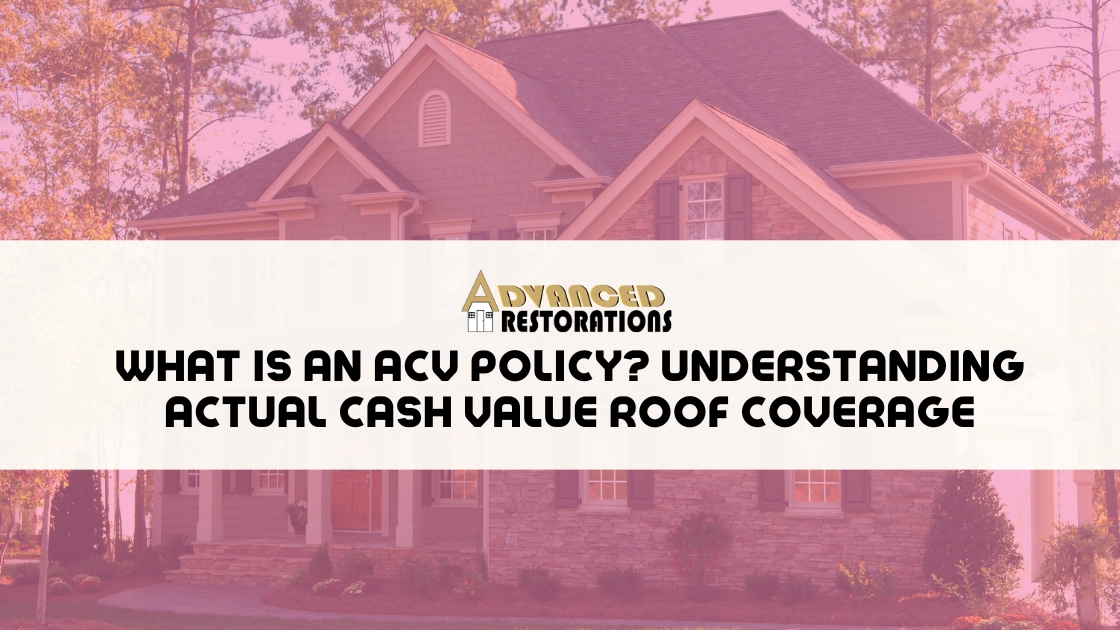
What Is an ACV Policy? Understanding Actual Cash Value Roof Coverage
Insurance can be a lifeline when your roof is damaged, but not all policies are created equal. Many homeowners are surprised to find that their plan only covers Actual Cash Value (ACV) rather than the full replacement cost of their roof.
While ACV coverage might sound fine on the surface, it often results in much lower payouts than homeowners expect. If you have an ACV policy, it’s important to understand how it works, why it pays less, and what you can do to protect your home when damage strikes.
How ACV Policies Work
ACV stands for Actual Cash Value—essentially the current, depreciated value of your roof at the time of damage. Insurance companies calculate ACV by taking the cost to replace your roof today and subtracting depreciation based on age, condition, and expected lifespan of the materials.
For example:
- A new roof today costs $18,000.
- Your roof is 15 years old with a 30-year life expectancy.
- The insurance company applies 50% depreciation.
- Your payout: $9,000 (instead of the full $18,000).
That means you’d need to cover the other $9,000 out of pocket to complete the project.
Why Payouts Are Lower Than Expected
ACV policies don’t account for the actual cost of restoring your roof to new condition. They only reimburse what your roof is “worth” in its aged, used state. Because roofs naturally lose value over time, ACV coverage almost always leaves homeowners with a shortfall.
This is especially frustrating after storms, when neighbors with replacement cost policies may get full coverage while ACV policyholders struggle to cover the gap.
The Impact on Homeowners
For many families, discovering that an ACV policy won’t pay for full replacement comes as a shock—often at the worst time, right after major storm damage. The result is:
- Unexpected out-of-pocket costs: Thousands of dollars needed immediately to complete repairs.
- Delays in protecting the home: Homeowners may postpone necessary work while trying to find funds.
- Risk of further damage: Waiting too long can lead to leaks, mold, and structural issues that cost even more.
What You Can Do if You Have an ACV Policy
- Review Your Policy: Look for “Actual Cash Value” language in your roof coverage. If you’re unsure, ask your insurance agent to confirm whether you have ACV or replacement cost coverage.
- Know Your Roof’s Age: The older your roof, the greater the depreciation applied. Even a roof in good condition may be valued far below replacement cost.
- Get a Professional Inspection: Understanding the true condition and estimated cost of replacement helps you prepare for potential shortfalls.
- Consider Financing Options: If your payout isn’t enough, financing can bridge the gap between what insurance pays and the actual cost to restore your home.
How Financing Bridges the Gap
At Advanced Restorations, we’ve seen many homeowners caught off guard by ACV policies. That’s why we offer flexible financing options to help cover the difference.
- Affordable monthly payments tailored to your budget
- Options for low or no interest for qualified applicants
- Quick online applications with fast approvals
- Financing available even without perfect credit
By combining your insurance payout with financing, you can get the full replacement your home needs—without compromising on quality or waiting until damage gets worse.
Don’t Let ACV Coverage Leave You Exposed
An ACV policy might provide some help, but it rarely covers the full cost of roof replacement. If you find yourself facing a shortfall, financing gives you the ability to move forward confidently, keeping your home safe and your investment protected.
Call Advanced Restorations at 417-962-8844 to schedule your free roof inspection and learn more about financing options for ACV policy shortfalls.
